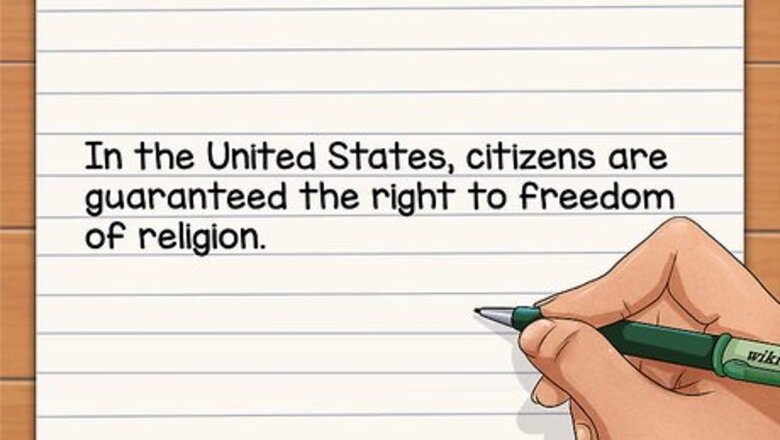
views
- You need a citation for the Constitution if you reference it directly or quote it.
- The format for your in-text and bibliographic citation differs depending on whether you’re using MLA, APA, or Chicago style.
- For APA and MLA style, your in-text citation goes inside of the sentence where you’re quoting or referenced the Constitution.
- In Chicago style, use a footnote for your in-text citation; for the bibliography, the citation is optional depending on the reference style you’re using.
Citing the U.S. Constitution in APA
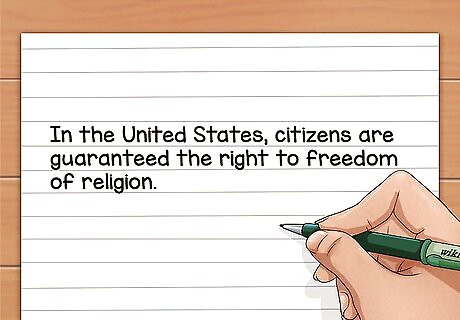
Create a sentence that needs a citation. Your sentence will need a citation if you paraphrase or quote parts of the Constitution. You can use information from the Constitution to back up an argument, such as arguing for a certain freedom in an opinion paper. For example, you might write the following: "In the United States, citizens are guaranteed the right to freedom of religion." You may also write the following example that quotes the Constitution: The U.S. Constitution notes that "Congress shall make no law respecting an establishment of religion, or prohibiting the free exercise thereof."
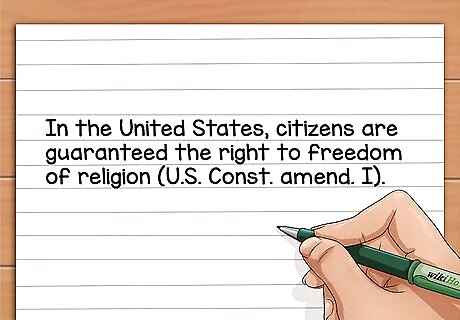
Add an in-text citation. An in-text citation generally goes at the end of a sentence, though in some cases it follows an author's name or article in APA. Nonetheless, for the Constitution, it will often go at the end of the sentence. Start with the open parenthesis, followed by "U.S. Const." and the amendment or article number. For an amendment, use "amend." and for an article, use "art." and "§" for the section. Follow with a close parenthesis. The citation goes before the period but after any quotation marks. Use Roman numerals for amendments and articles, and Arabic numerals for sections and clauses. The first example would look this way: In the United States, citizens are guaranteed the right to freedom of religion (U.S. Const. amend. I). In the second example, you could add the citation after the mention of the Constitution: The U.S. Constitution (amend. I) notes that "Congress shall make no law respecting an establishment of religion, or prohibiting the free exercise thereof."

Make a reference at the end. While you've noted where it came from in your paper, you also need to add it to your citations at the end of your paper. The basic format for citing the Constitution is the same for both in-text citations and end references. An end citation would look like the following example: U.S. Const. amend. I.
Add a date as needed. If an amendment or clause is currently in use, you don't need to add a date. However, if you're referring to an out-of-date part of the Constitution, you should add a date stating when it was repealed. The date will go after the citation: Prohibition was the law of the land in the 1920s and early 1930s (U.S. Const. amend. XVIII, repealed 1933). The end citation would look like this example: U.S. Const. amend. XVIII (repealed 1933).
Citing the U.S. Constitution in MLA Style

Create your sentence. Just like in APA style, you need to create a sentence where you need a citation. You can cite the U.S. Constitution as a reference for making a legal argument, for example, when creating an opinion paper. For instance, you can use the same example from above: In the United States, citizens are guaranteed the right to freedom of religion. Another example is the following sentence: The U.S. Constitution notes that "Congress shall make no law respecting an establishment of religion, or prohibiting the free exercise thereof."
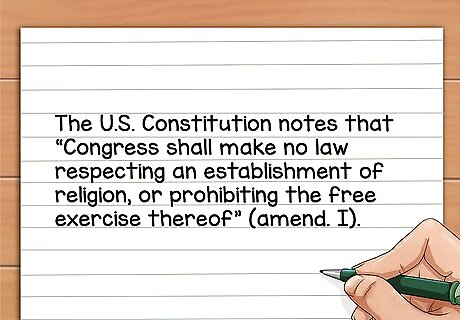
Place the in-text citation at the end of the sentence. Unlike APA, the in-text citation always comes at the end of the sentence, before the period and after the quotation mark. However, like APA, you can leave off "US Const." in the citation if you use it in the sentence. Start with an open parenthesis, then add "US Const." Follow that with the amendment, section, article, and/or clause and a close parenthesis. Use Roman numerals for amendments and Arabic numerals for sections. The example would look like this sentence: In the United States, citizens are guaranteed the right to freedom of religion (US Const. amend. I). The second example would look this way: The U.S. Constitution notes that "Congress shall make no law respecting an establishment of religion, or prohibiting the free exercise thereof" (amend. I).

Make an end reference. Like APA, the MLA end reference is fairly similar to the in-text citation. However, unlike APA, you'll spell out more of the reference at the end than you do in the in-text citation. Also, you'll usually use more capitalization and italicize "U.S. Constitution." The end-text citation will look like this example: U.S. Constitution. Amend. I
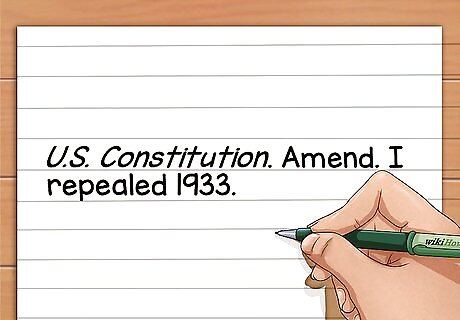
Add a year if necessary. If the amendment has been appealed or you want to place emphasis on the year it was enacted, you can add a date. Simply add it after the amendment or section with a short description before it, such as "repealed 1933."
Citing the U.S. Constitution in Chicago Style

Create your sentence. Of course, first you need to write a sentence that needs a citation from the U.S. Constitution. Try writing one that directly references or quotes the U.S. Constitution. Only then will you need a citation at the end. Take the same example from above: In the United States, citizens are guaranteed the right to freedom of religion.

Add a footnote. Chicago style works a little differently in that you add a footnote rather than a citation in text. Basically, you tell your word processing software to add a footnote at the end of the sentence, after the period this time. It creates a number that connects to the same number at the bottom of the page. For example, your sentence would look this way: In the United States, citizens are guaranteed the right to freedom of religion. The number will be in superscript, as it is in the example. To add a footnote, put the cursor at the end of the sentence. Choose "References" and "Insert Footnote." The word processing system will do the rest.

Create the footnote. The footnote at the bottom of the page is where you'll put your reference. Start with "U.S. Constitution." Follow that with the amendment, section, article, and/or clause. Use Roman numerals for articles, and Arabic numbers for everything else. For example, your footnote would look like the following example: 1. U.S. Constitution, amend. 1. When naming a section, use "sec." not the section symbol "§."

Skip the final citation. Unlike APA and MLA, you don't need an end citation when you're citing constitutions. The main reason you don't need the citation is that these are common documents that are easy to find, and the point of the end reference is to point the reader to the source.




















Comments
0 comment